Learn how to access Zoom for use within D2L (aka Brightspace, LMS).
You can use Zoom meetings strictly with a D2L course when you just want those that
are enrolled in your course to be attending the meetings.
Note: If you have created a free Zoom account in the past using your augusta.edu email
you will need to visit zoom.augusta.edu, click Sign In, and log in using your NetID and password. You will be asked if you want to move your current account into the AU Zoom account.
Agree to the account move prior to your first use of Zoom in D2L for classes or you
may not be able to use the tool correctly. If you have never had a Zoom account in
the past then you can ignore this note.
- Within an internet browser, go to D2L and log in with your AU NetID and password.
- Access your D2L course.
- In the navigation bar click Zoom.
- If you have not created your AU Zoom account through the Zoom Web Portal and this is the first time accessing the Zoom link through AU Tools within your D2L course you will need to authenticate your account.
At the Zoom Authentication screen click Authenticate. This will create your AU Zoom account. After authenticating your account, this screen
will no longer appear in the future when you click the Zoom link.
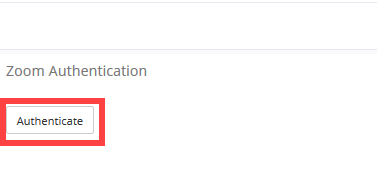
- It will ask if you would like for the Zoom Calendar to operate using your account.
Click the Accept button. This screen also will not appear again after your selection so make sure
you click Accept. If you happen to click cancel on this message it will mean that your Zoom meetings
that you schedule will not get auto-populated to the course calendar. The course calendar
can provide a convenient way for you and your students to access your meeting links.
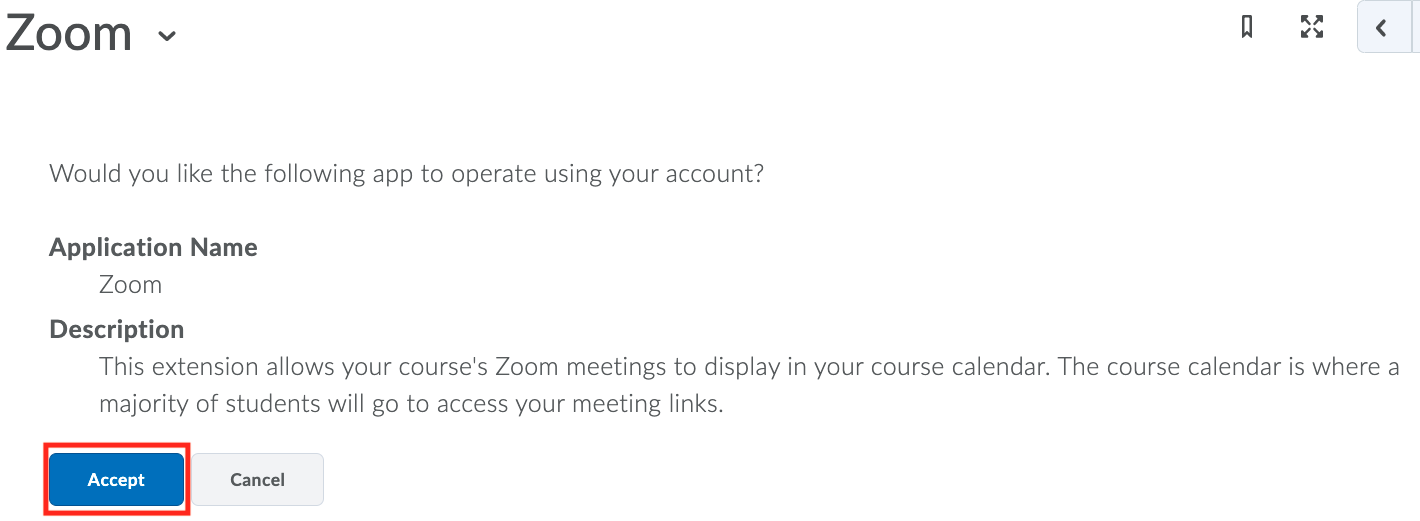
- You will then be taken to the Zoom Integration home screen where you can see upcoming
meetings, previous meetings, your personal meeting room, your cloud recordings, as
well as a button for scheduling a new meeting.

Creating/Scheduling a Zoom Meeting Within D2L
Learn how to create and schedule a Zoom meeting from within D2L.
Make sure you are logged in to D2L and at the Zoom Integration home screen.
- Click on the Schedule a New Meeting button.
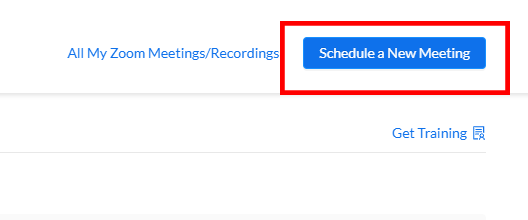
- You will be taken to the Schedule a New Meeting page where you can begin to fill out
the meeting options that you desire. (See descriptions of each item below the picture)
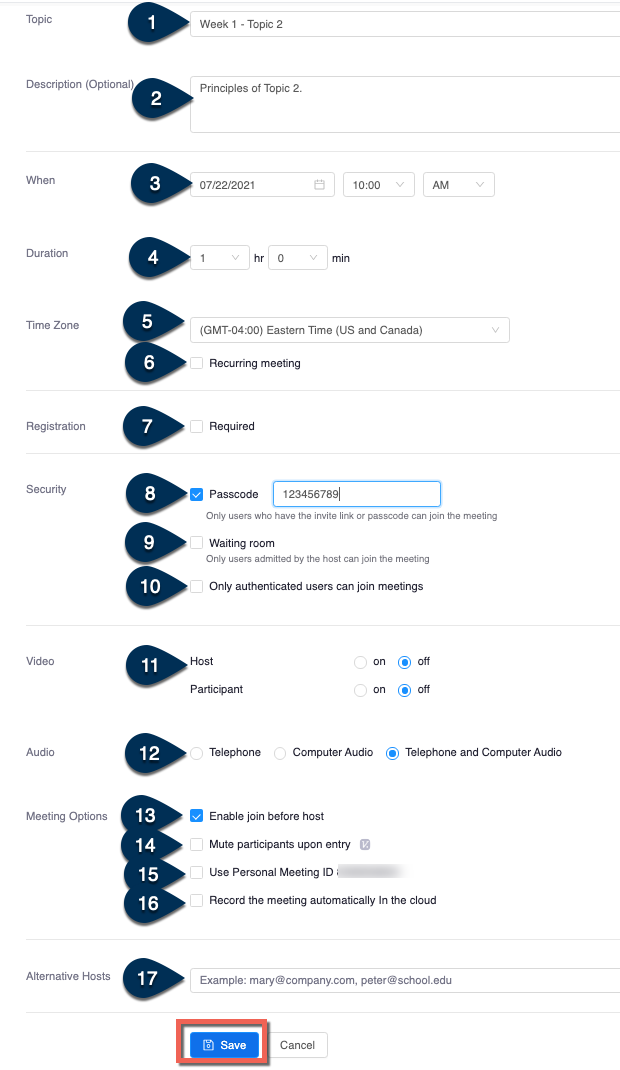
- Topic: Enter in the name (or title) of the meeting. Note: Be very descriptive with the name of your meeting as it will stand out and be easier
to notice in the Event Calendar widget within D2L.
- Description: Enter in a description about the meeting. (This is optional)
- When: Choose the date and time for the meeting. You can start your meeting at any time
before the scheduled time.
- Duration: Choose the approximate duration of the meeting. Note: This is only for scheduling purposes. The meeting will NOT end after this length
of time
- Time Zone: By default, Zoom will use your computer's time zone. Click on the drop-down to choose
a different time zone.
- Recurring Meeting: Choose if you would like a recurring meeting, i.e. the meeting ID will remain the
same for each session. If checked, you will then have the options for Recurrence (Daily,
Weekly, Monthly, no Fixed Time), Repeat every (Days/Weeks/Months), and End date (Specific
date or 1-20 occurrences).
- Registration: Allows you to have your participants register with their e-mail, name, other questions,
and custom questions.
- Passcode: You can select and input your meeting passcode here. Participants joining the meeting
via typing in your meeting ID will be required to input this passcode before joining
your scheduled meeting. Those joining via the "join meeting URL" will not be required
to enter the passcode as it is included in the link.
- Enable waiting room: Allows the host to control when participants join the meeting by placing them in
a waiting room.
- Only authenticated users can join meetings: Participants need to authenticate (log in with AU username and password) before
to joining the meetings.
- Host Video: Choose if you would like the host video on or off when joining the meeting. Even
if you choose off, the host will have the options to start their video after joining
the meeting.
Participant Video: Choose if you would like the participants' video on or off when joining the meeting.
Even if you choose off, the participant will have the option to start their video
after joining the meeting.
- Audio: Choose what audio options you want to allow for the meeting (Telephone, Computer Audio,
or Both).
- Enable Join Before Host: Allow participants to join the meeting without you (host) or before you (host) join.
- Mute Participants Upon Entry: If join before host is not enabled, this will mute all participants as they join the
meeting.
- Use Personal Meeting ID: Check this if you want to use your Personal Meeting ID. If not selected, a random
unique meeting ID will be generated.
- Record the meeting automatically: Check this if you want the meeting to be automatically recorded when you join the
meeting as the host. You will have the option to record the meeting locally on your
computer or in the cloud.
- Alternative Hosts: Enter the email address of another Zoom user with an AU license on your account to
allow them to start the meeting in your absence.
- When you are done setting all of your meeting options, click the Save button.
- You will then see the meeting information page. This page will show you what settings
you have applied to the meeting. It will also provide you ways you can invite attendees
to your meeting by giving you the "Join URL" or you can "Copy the invitation" of the meeting to email to participants. From this screen is where you can also
delete, edit, or start the meeting. NOTE: D2L will automatically generate a calendar event for your Zoom meeting and put it
in your D2L Course Calendar.
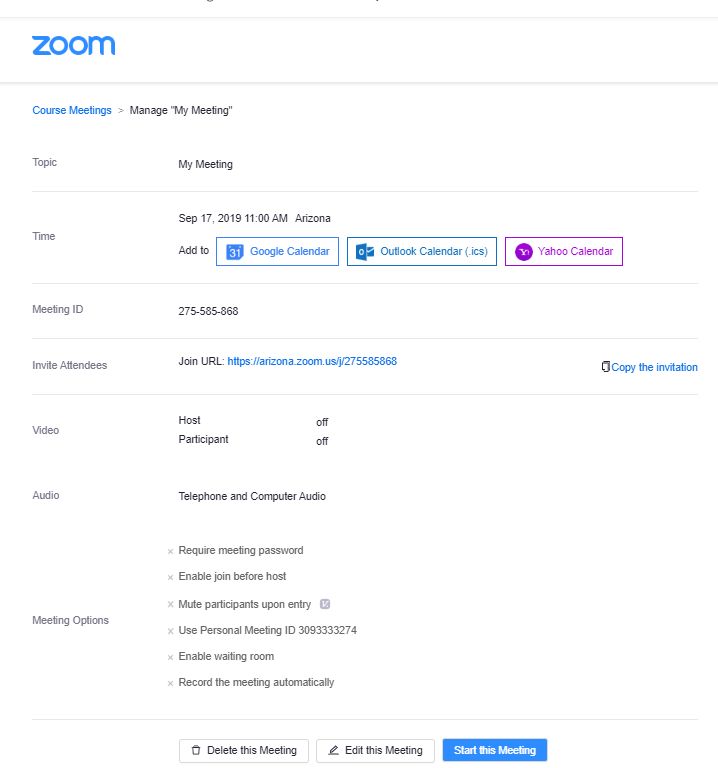
To get back to the main D2L Zoom page click the Course Meetings link at the top.
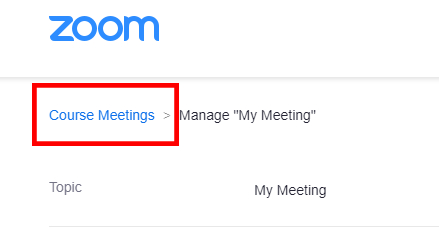
You will then see your meeting listed under the "Upcoming Meetings" tab. This is also where you can Start or Delete the meeting. To go back to the meeting information page just click on the title or
"Topic" of the meeting.

Share Zoom Meeting From Within D2L
Learn how to share Zoom meeting information from within D2L.
Once you have created and scheduled your meeting your students enrolled in your course
will be able to find information about the meeting through the Calendar widget on your D2L course homepage. If for some reason you turned off the Calendar
widget for your D2L course we strongly recommend you add that widget back to your
course homepage as this is how students will mainly see and access the Zoom meetings
you create. Also, your students will be able to go to the Zoom link in your course and see and join scheduled meetings for your course. Here is
an example of what your students will see in the Calendar widget when a Zoom meeting
for their course has been added.
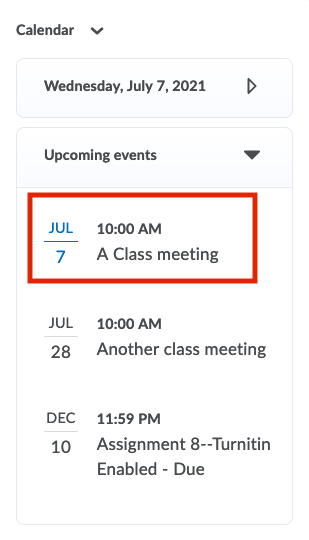
When you or the student clicks on that event in the calendar, they will be taken to
a screen that will have a link to the actual Zoom meeting. This is how your students
can join the meeting. NOTE: If you are the instructor and creator of the meeting this is NOT where you can start
the meeting and be the host of the meeting. Follow the instructions in section 5 for
starting the meeting as the host.
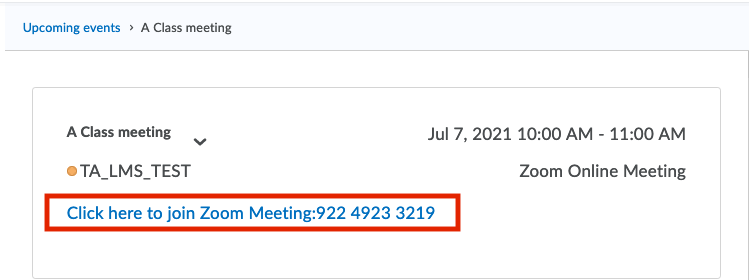
Starting a Zoom Meeting as Host from within D2L
Learn how to start a Zoom meeting as the host from within D2L.
In D2L, if you are the creator and host of a meeting you will need to start the meeting
from the D2L Zoom integration home screen.
- Access the Zoom Integration home screen for instructors by going into a D2L course and click on Zoom.
- Once at this home screen you will see a listing of all your upcoming meetings. Find
the meeting you want to start and click the Start button for that particular meeting. This is also where you can delete a meeting you
have created. Just find the meeting you want to delete and click the Delete button for that particular meeting.

Install Zoom App
- When you click the meeting link or the start button it will attempt to launch the
Zoom meeting. If you don't have the Zoom desktop application installed, you may need
to install from AU's Software Center.
*For a Personal Device click here.
Audio Conference Options
Once the Zoom app is installed on your computer it should launch the meeting. It will
prompt you to choose which audio option you want to join the meeting with.
Join By Computer Audio
The default selected option is to join by Computer Audio. This option is always free and it works in the Zoom app for desktop as well as your
smartphone mobile device app as well. You will just need a microphone (built-in, USB,
or in-line) as well as speakers or headphones. If you want to test your microphone
and speakers before joining you can click the link that says Test Computer Mic & Speakers. If you'll always join Zoom meetings via the Computer Audio then you can check the box to Automatically join audio by computer when joining a meeting. Once you are ready to join by computer audio you'll just click the Join Audio Conference by Computer button.
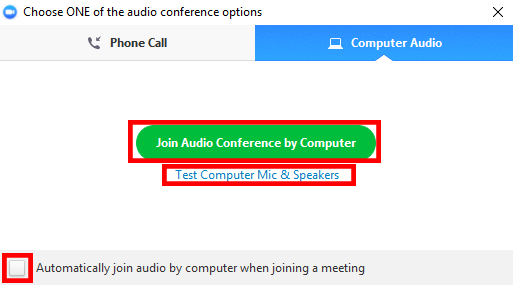
Join by Phone Call
The other audio option is to join via a Phone Call. You can join a Zoom meeting via
teleconferencing/audio conferencing (using a traditional telephone). This is useful
in occasions where:
- you do not have a microphone or speaker on your PC/Mac
- you do not have a smartphone (iOS or Android) while on the road, or
- you cannot connect to a network for video and VoIP/computer audio
- You can choose what country (from the drop-down menu) you are calling from and it will provide you toll numbers
that you can dial. If you dial a toll number, your carrier rates will apply.
- You will then be prompted to enter the Meeting ID (9 or 10 digit number) provided to you by the host, followed by the # key.
- You will then be prompted to enter in your unique Participant ID. This only applies if you have joined on the computer or mobile device or are a panelist
in a webinar. Press # key to skip.
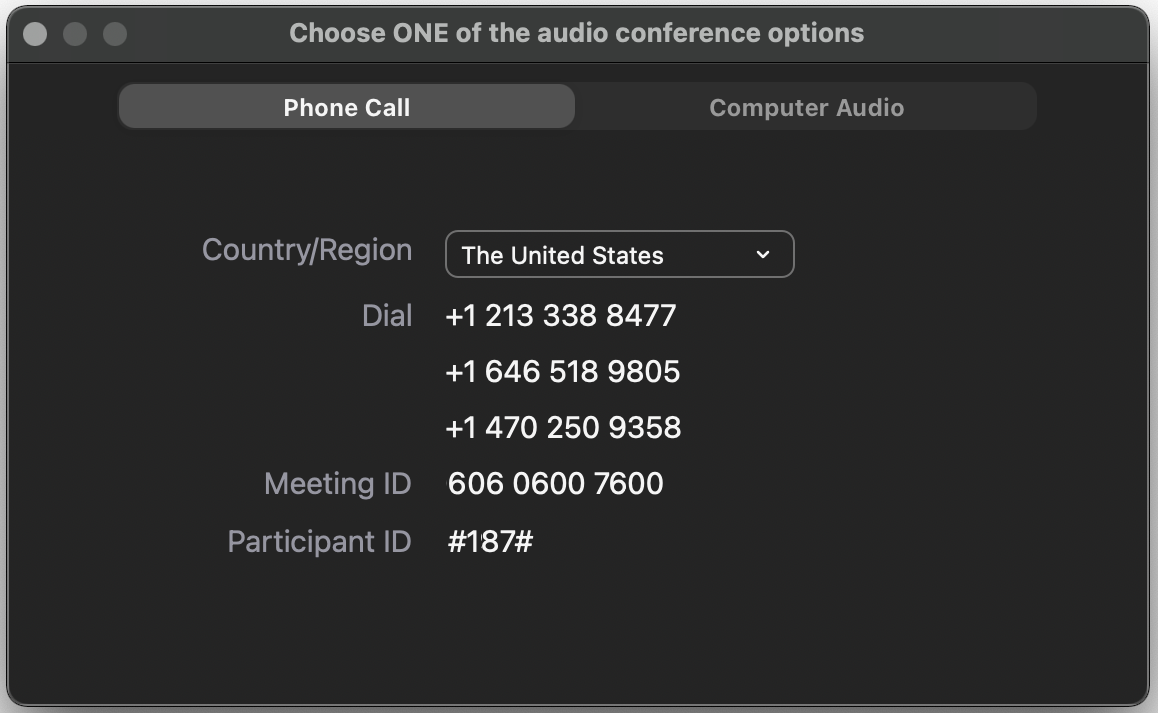
Detailed information about joining by teleconference/audio conferencing.
Manage Participant List
Learn how to manage the participant list in a Zoom meeting.
As the host of the meeting, you have lots of options regarding managing your participants.
From the open Participants Window, options are: 
- Invite: This button will bring up the option to invite to the meeting by contacts or default
email application.
- Mute All: This button will mute all of the participants in the participant list.
- More: This button will give you more options such as
- Mute participants upon entry
- Allow participants to unmute themselves
- Play enter/exit chime
- Lock Meeting: Lock meeting will prevent anyone new from joining the meeting.
To the right of each participant's name you will see a microphone icon and a video icon.

These icons will allow you to turn on/off individual participants microphones or video
cameras.
If you hover over an individual participant you will see options to Mute/Unmute their microphone as well as a More button.
If you click on the More button you will have options to:
- Chat: Starts a private chat with that participant.
- Ask to Start (or Stop) Video: You can ask the participant to start or stop their video camera feed.
- Make Host: Makes the participant the host of the meeting.
- Make Co-Host: Makes the participant a co-host of the meeting.
- Allow Record: Allows the participant the ability to record the meeting locally.
- Rename: Allows you to rename the participant's name.
- Remove: Removes the participant from the meeting.
Sharing Your Screen
Learn how to share your screen and documents in a Zoom meeting.
For detailed information visit Zoom's Support Page on "How Do I Share My Screen".
Here you will be shown the basics of sharing your desktop screen, a document, or a
specific window or application that you have open on your computer.
- To share your screen, click the Share Screen button located in your meeting toolbar

- Select the screen you want to share. This is where you can choose from several options.
You can choose to share the entire Desktop screen, a whiteboard, an iPhone/iPad screen, or an individual application, window, or document that is already open on your computer. So to share a PDF, Word document, PowerPoint
document, etc., you would open that document on your computer and then choose to share
your screen and select that document to share.
- Optional additional settings you can choose are to "Share computer sound" and "Optimize for full screen video clip". Sharing the computer sound will share any sound played by your computer. The optimize
for full screen video clip should be selected when you want to share a video clip
in full screen mode.
Once you have chosen what you want to share, the meeting controls will move into a
window that you can drag around your screen. You can see in the example below I chose
to share a Word document that was open.
The meeting controls toolbar have the following options during a screen share session:

- Mute/Unmute: Mute or unmute your microphone.
- Start/Stop Video: Start or stop your in-meeting video camera feed.
- Manage Participants: View or manage the participants (if you are the host).
- Polls: Create, edit or launch your polls.
- New Share: Start a new screen share. You will be prompted to select which screen/application
you want to share again.
- Pause Share: Pause your current screen share.
- Annotate: Use screen share tools for drawing, adding text, etc.
- More: Hover over this button for additional options such as:
- Chat
- Breakout Rooms
- Invite
- Record on this computer
- Record to the cloud
- Disable participants annotation
- Hide Video Panel
- Audio Options...
- Video Settings...
- Optimize Share for Full-screen Video Clip
- End Meeting
To annotate over a screen share session, click on the Annotate button in the screen share toolbar.
You will then see the Annotate toolbar appear.

The different tools on the annotation toolbar are:
- Mouse
- Select
- Text
- Draw
- Stamp
- Spotlight/Arrow: Turn your cursor into a spotlight or arrow.
- Eraser
- Format: Change the format options of the annotation tools.
- Undo
- Redo
- Clear
- Save: This allows you to save all annotations on the screen as a screenshot. The screenshot
is saved to the local recording location.
To stop a share screen session, click the Stop Share button in the screen share toolbar.
Chat Tool
Learn how to use the chat functions in a Zoom meeting.
For detailed information visit Zoom's Support Page on "In-Meeting Chat".
The Chat tool allows you to send chat messages to other users within a meeting. You
can send a private message to an individual user or you can send a message to the
entire group. As the host, you can choose who the participants can chat with or to
disable the chat entirely.
Access the Chat Tool Click on the Chat button in the meeting toolbar.

The chat window will then open on the right. You can type a message into the chat
box at the bottom or click on the drop down next to To: if you want to send a message to a specific person. As a host the More drop down
will give you options to save the chat, share a file in the meeting, and you can choose who attendees can chat with (host only or everyone).
Share a File in Chat To share a file in the chat window, click on the File button, select your computer.

You will then need to browse to the location of the file you want to share, select it and choose to open it. Your file will then upload to the chat and will give you a message that it sent
successfully. The participants of the meeting will then see the option in their chat
window to download the file locally to their computer.
Every time you receive a new chat message and the chat window is closed or not visible,
the chat button in the toolbar will flash orange and remain orange until you view
the chat.

When you create a private chat message with just one person it will have the word
"(Privately)" in red and parenthesis within the whole chat window and it will say who it is from
and who it is to.
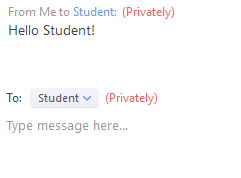
Polling
Learn how to create and run polls in a Zoom meeting.
For detailed information visit Zoom's Support Page on "Polling for Meetings"
The polling button in the meeting toolbar allows you to create multiple choice polling
questions for your meetings. You will be able to launch the poll during your meeting
and gather the responses from your attendees. You also have the ability to download
a report of polling results after the meeting.
Note: Currently during the meeting you are not able to see how each individual responded
to the poll. You can see it in the reports after the meeting is over. This request
to see how individual responded during a meeting has been made and will be a feature
in the near future.
When you are in the meeting, to create and add a poll, click on the Polls button in the meeting toolbar.

The poll window will appear. Click on Add a Question button.
This will launch the Zoom web portal in a browser where you can create your poll.
- Enter a title for the poll and type your first question. You can mark the question as a single choice or multiple choice question.
- Type in answers to your question.
- If you want to add another question, click the Add a Question link to create a new question for that poll.
- When you are done creating your questions click the Save button.
When you go back into the Zoom meeting you will see your poll you just created. To
launch the poll to all of the meeting participants click the Launch Polling button. When the poll is launched the participants can then begin responding. When
they submit their answers you will see the results of how the overall group responded
to the poll questions. When you are ready to close the poll, click the End Polling button. Once the polling has ended, you as the host have the option to share the
results with the rest of the participants. To share results, click the Share Results button. If you want to re-launch the poll because maybe not everyone was able to
respond in the time allotted you can click the Re-launch Polling button.
Breakout Rooms
Learn the ins and outs of utilizing breakout rooms in Zoom.
For additional information visit Zoom's Support Page on "Managing Breakout Rooms".
Breakout rooms allow you to split your Zoom meeting in up to 50 separate sessions.
The meeting host can choose to split the participants of the meeting into these smaller
groups automatically or manually, and can switch between session at any time. Breakout
room participants have full audio, video and screen share capabilities. You can also
pre-assign participants to breakout rooms when you schedule your meeting instead of doing it
live during the meeting.
Limitations
- Only the host can assign participants to breakout rooms.
- Co-hosts can leave and join any breakout room only if they join a breakout room assigned
to them by the host.
- Users joined into a Zoom meeting from the Zoom Mobile App can participate in breakout
rooms, but cannot manage them.
- Users joined using Chromebooks/Chrome OS or Zoom Rooms are unable to join breakout
rooms, but the main meeting room can be used as an alternative space for these users.
- If the meeting is being cloud recorded, it will only record the main room, regardless
of what room the meeting host is in. If local recording is being used, it will record
the room the participant who is recording is in. Multiple participants can record
locally.
- You can create up to 100 breakout rooms with up to 1000 participants in each room.
Learn how to create and manage breakout rooms during a meeting.
The instructions below will walk you through how to create breakout rooms while you
are within a Zoom meeting.
For more detail and further instructions, visit Zoom's support page on "Managing breakout rooms".

- To create breakout rooms, click on the Breakout Rooms button in the meeting toolbar.

- Select the number of rooms you would like to create, and how you would like to assign your participants to those
rooms. Selecting Automatically will let Zoom split your participants up evenly into each of the rooms. Selecting
Manually will allow you to choose which participants you would like in each room. If Let participants choose room is selected participants will be able to view and select from a list of breakout
rooms the host has created. They will be able to enter and leave breakout rooms freely.
When finished selecting one of those options, click Create Breakout Rooms.
- If you choose for Zoom to automatically assign the participants to the room, that
will occur instantaneously. If you choose to manually assign participants to the rooms
you will now have to assign them to the rooms. To do so, select the Assign link next to the room you wish to assign participants to and select the checkbox next to each participant you wish to assign to that room.
- Once you are finished assigning participants to the rooms and are ready to begin the
breakout rooms, click the Open All Rooms button.
Pre-assign Breakout Rooms
Learn how to pre-assign breakout rooms ahead of your Zoom meeting.
If you want to assign your breakout rooms ahead of your meeting you can do that. Right
now you can only do this from within the Zoom Web Portal. You cannot pre-assign breakout rooms from within your D2L course (AU Tools > Zoom).
From within the web portal you will access your meeting and edit the meeting. You'll
have two options after selecting the "Breakout Room pre-assign" feature for the meeting. You can create the breakout rooms and assignments manually
by hand from within the web portal OR you can use a CSV file and import it to your
meeting. For small classes doing it manually by hand is manageable but if you have
classes of 50 or more this can be a tedious process of entering emails in one at a
time.
For more detail and further instructions, visit Zoom's support page on Pre-assigning participants to breakout rooms.
Limitations
- You can only pre-assign participants that have a Zoom account (internal or external
Zoom users). This means you can't add someone to a room if they don't have an existing
Zoom account.
- When pre-assigning participants manually using the web portal, you can only pre-assign
internal Zoom users that are in the same account (AU Zoom account users).
- To pre-assign participants that are external Zoom users (not in AU Zoom account),
you will need to use the CSV file method.
- Up to 100 rooms can be created and you can assign up to 1000 participants (using either
method, manual or CSV). Keep in mind regular Zoom meetings can only host up to 500
participants. If you need a larger meeting you will need to make that request to EMAIL@augusta.edu.
- If the meeting is being cloud recorded, it will only record the main room, regardless
of what room the meeting host is in. If local recording is being used, it will record
the room the participant who is recording is in. Multiple participants can record
locally.
Note: If you are editing a recurring Zoom meeting and pre-assigning breakout rooms you
need to make sure you choose "Edit All Occurrences" when it asks you what you want to edit. You cannot pre-assign breakout rooms to just
ONE instance of a recurring meeting. It won't save your pre-assigned rooms if you
choose "Edit this Occurrence".
Pre-assign participants to breakout rooms using the web portal (manual process)
- Sign in to the Zoom web portal.
- Select Meetings on the left-hand side.
- You can Schedule a New Meeting or select an existing meeting that is already scheduled.
- If you are selecting an existing meeting scroll down to the bottom of that meetings
page and select Edit.
- In the Meeting Options section, select Breakout Room pre-assign and click Create Rooms.

- Click the + icon beside Rooms to add breakout rooms.
- Hover over the default breakout room name and click the pencil icon that will appear to rename
it if desired.
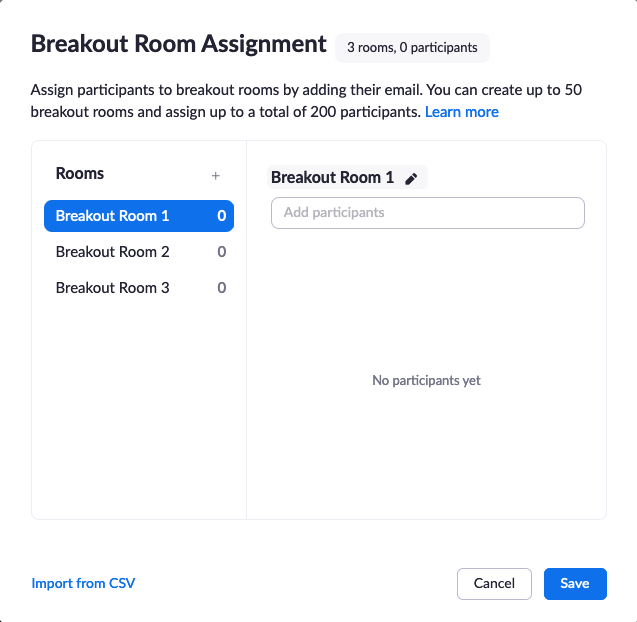
- In the Add participants text box, you can search for participants' name by entering the full first and last
name or just type their AU email address (JagID@augusta.edu) and press Enter on your keyboard to add them to the breakout room. You can only add internal AU Zoom
users here. To pre-assign participants that are outside our AU Zoom account you will
need to import via a CSV file.
- (Optional) Use these options to edit your breakout rooms and participants:
- Click and drag a participant's email address to change the order.
- Hover over a participant's name to see options to move them to another room or remove
them from the current room.
- To delete a breakout room, hover your mouse over the room name in the left panel and
click the trash bin icon.
- Click Save to save your breakout room pre-assignments to your meeting.
Pre-assign participants to breakout rooms using a CSV file
For larger courses and to pre-assign users that are outside of our AU Zoom account
you will want to use a CSV file. The steps below will walk you through downloading
your course roster in D2L, downloading the CSV template file, formatting the CSV file,
and applying it to your meeting.
Step 1 - Download D2L Course Roster
You'll need to gather a list of all of your student's email addresses that are in
your course so to do this you will need to download/export your D2L course roster.
- Within your D2L course select Grades in the navigation bar.
- Select Enter Grades.
- Select Export.
- The only checkboxes on this page that you need to check appear under the User Details
section. Place a checkmark in the following boxes (Last Name, First Name, Email). All other boxes on this page should be unchecked. You don't need to export any
of the grade values or grade items.
- Select Export to CSV.
- Select Download when the file is ready. This will download the file to your computer. Open the file
up in Microsoft Excel or another program that can open and edit CSV files. Keep this
document handy as you will need it later.
Step 2 - Download CSV template file from Zoom
- Sign in to the Zoom Web Portal.
- Click Meetings on the left-hand side.
- You can Schedule a New Meeting or select an existing meeting that is already scheduled.
- If you are selecting an existing meeting scroll down to the bottom of that meetings
page and select Edit this Meeting.
- In the Meeting Options section, select Breakout Room pre-assign and click Import from CSV

- Click download to download a sample CSV file you can fill out.
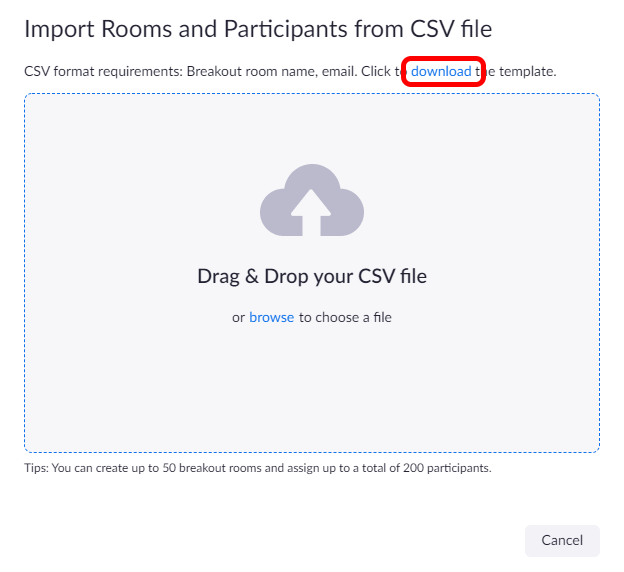
- Open the CSV file with spreadsheet software like Microsoft Excel or something comparable.
- Fill in the Pre-assign Room Name column with the breakout room name, and the Email Address column with the assigned participant's email address. You can copy/paste your student's
email addresses from the course roster that you previously downloaded. Important: When assigning your AU students, make sure you use their "@augusta.edu" email address. Also, DO NOT alter the names of the column headers "Pre-assign Room Name and Email Address". These need to be left as is or else you will get errors when attempting to upload
the file to your meeting.
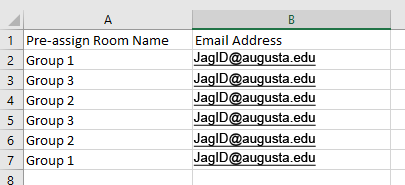
- Save the file in CSV format. DO NOT save it as a normal Excel file. It needs to specifically be in CSV
format.

- Drag and drop the CSV file or browse to find the CSV file on your computer to import
it into your meeting within the web portal. Zoom will verify that the email addresses
all have a Zoom account.
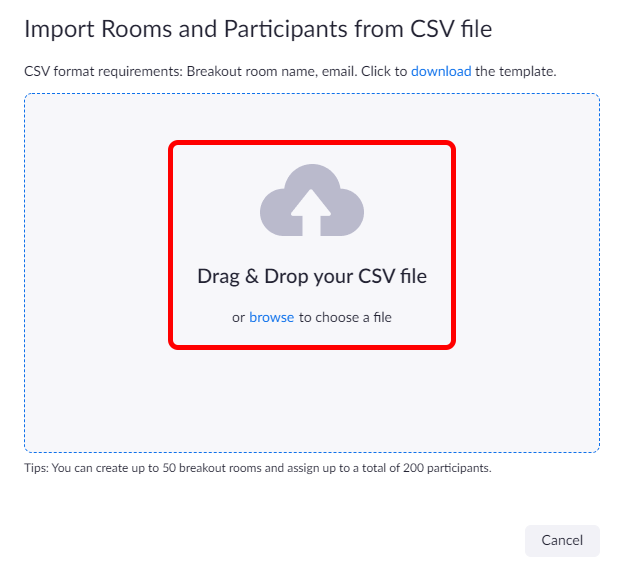
- Zoom will verify that the email addresses all have a Zoom account. You should then
see all of our breakout rooms in the left panel and when you click on each room you
will see the students you have assigned to those rooms. Click Save.
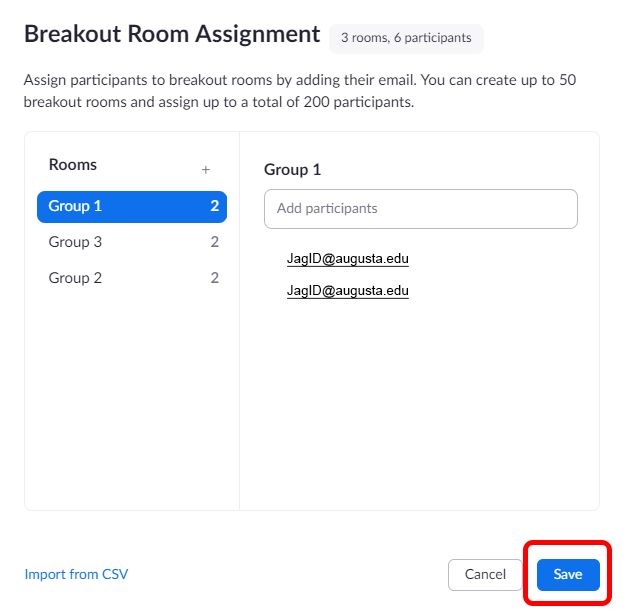
- Click Save again to save your meeting. Now, once you are within your meeting then you will click
on the Breakout Room button in the Zoom toolbar to bring up your assigned breakout rooms and to then Open All Rooms. If some students don't happen to get pre-assigned properly then you can manually
assign them prior to opening the rooms. Likely reasons why students don't get properly
assigned to rooms is that they haven't logged into the Zoom application with their
AU Zoom account therefore Zoom doesn't see their AU email address to properly put
them in the assigned room. To properly login to the Zoom app students should sign
in here first.
Starting a meeting with pre-assigned breakout rooms
- Start the meeting that has the pre-assigned breakout rooms applied.
- When all of your participants are present in the meeting, click Breakout Rooms in the meeting controls to access the breakout rooms you created. Those that are present
in the meeting should get assigned properly to their rooms. If you open the Breakout
Rooms button too early (i.e. when you immediately enter the meeting as the host) your
students likely won't get assigned properly to your rooms. Only the students that
are present in the meeting when you click Breakout Rooms will get assigned properly.
Any student who joins the meeting after you have clicked that button they will not
get properly assigned.
- If a participant who comes in late is not assigned to the breakout room you specified
you can click the Recreate button and choose Recover to pre-assigned rooms. This will recover the pre-assigned rooms and put everyone who is presently in the
meeting in their appropriate breakout rooms.
Manually assign a participant who doesn't get assigned properly to their pre-assigned
breakout room
If during your meeting you click on the breakout room button in the Zoom toolbar and
click on the Open All Rooms button in the breakout room window and you find that a
participant has not been assigned to a room you can manually assign them to a room.
- Once you have opened up your breakout rooms if you see a category at the top of the
breakout rooms window that says Unassigned it will show you what participants have
not been assigned to a breakout room.
- Hover your mouse over a participant's name and select the Assign To option and then
select which room you want to assign to them.
Recording
Learn how to record your Zoom Meetings.
For detailed information visit Zoom's Support Page on "Cloud Recording".
Cloud Recording (Default for Faculty/Staff Accounts)*to enable local recording Faculty & Staff see below
When you record a meeting a choose Record to Cloud, the video, audio, and chat text
are recorded in the Zoom Cloud. The recording files can then be downloaded to a computer
or streamed from a browser via HTML5 or Flash.
Start a Cloud Recording
- Click the Record button in the meeting toolbar.
- A menu prompt will appear, select Record to the Cloud.
- To stop the recording press Stop Recording or end the meeting.
Once the recording has been stopped, the recording must be processed before viewing.
Zoom will send an email to the host email address when the processing is completed.
In that email will be links to view the recording as well as share the recording with
others.
Record to Your Computer (Local Recording) (Default and only options for students)
Local recording allows users to record meeting video and audio locally to their computer.
The recorded files can then be uploaded to file storage websites like Box or Echo360's
Active Learning Platform (ALP), alternatively you can also opt-in to having all zoom
meetings copied to your Echo360 personal Library.
Enable Local Recording (faculty and Staff)
Login at zoom.augusta.edu using your AU JagID.

- Click the Setting option in the toolbar.
- Click the Recording tab across the top.
- If the toggle button is grey (seen above) click it, it will be blue when enabled.
- Log out/close web browser when complete.
- You will now be presented with Local or Cloud options for ad-hoc recordings and auto-recordings
when scheduling.
Start a Local Recording (only option for student accounts)
- Click the Record button in the meeting toolbar.
- A menu prompt will appear, select Record on this Computer.
- Hosts will see the following recording indicator in the top left corner when the recording
has started.
- In the participants window it will also display a recording indicator next to the
user who is actively recording.
- Once the meeting has ended, a prompt will appear stating "You have a recording that
needs to be converted before viewing." Wait for the recording to convert before it can be accessed. Note: If the meeting unexpectedly
shuts down or the conversion process is interrupted, the recording files could become
corrupted and non-recoverable.
- Once the conversion process is complete, the folder containing the recording files
will automatically open.
Recording File Formats:
- MP4: Audio/Video format the Zoom recording uses. This is named "zoom_0.mp4" by default.
Each subsequent recording is then in sequential order: zoom_0, zoom_1, etc.
- M4A: Audio format the audio-only file uses. This is name "audio_only.m4a" by default.
Each subsequent recording is in sequential order: audio_only_0, audio_only_1, etc.
- M3U: Playlist file to play/load all individual MP4 files (Windows only)
- Chat: Standard text or .txt file. This is named "chat.txt" by default.
Adjusting Zoom Cloud Recording Settings
Learn how to adjust your Zoom Cloud Recording Settings.
Within Zoom, you may want to adjust the Settings for Cloud recordings: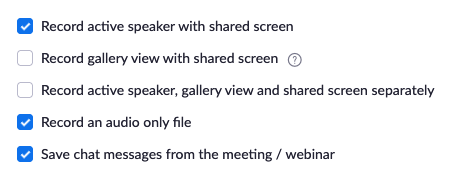 Recording to receive the correct format of recording that you desire. By default,
your account likely will render the following types of recordings:
Recording to receive the correct format of recording that you desire. By default,
your account likely will render the following types of recordings:
- Record active speaker with shared screen
- Record an audio only file
If you leave all options selected, Zoom will send all of these formats to your folder.
Zoom names all of the files the same so there is no way (other than viewing the recording)
to distinguish which type of recording it is. So, it is best practice to choose only
one recording version.
Note:
Cloud recordings will be deleted automatically after they have been stored for 365
days. If you need to maintain a copy, please download and store to box or Echo 360.
Meeting and Poll Reports
Learn how to access and export meeting and poll reports.
There are a few different types of reports that you can access regarding your Zoom
meetings, a Meeting Report and a Poll Report. A meeting report will tell you who attended your meeting, what time they joined,
what time they left, and for how long they were in your meeting. A poll report will
show you the specific results of your polls that you run in your meeting and how each
participant responded.
- Log-in to D2L (lms.augusta.edu) then access your course.
- Select Zoom
- Select Previous Meetings tab.

- Select Report for which meeting you want to view a report.
- You will see two tabs, a Meeting Report tab and a Poll Report tab.

- The Meeting Report tab will show you your meeting attendance information. You can
export these results to CSV if you desire.
- The Poll Report tab will show you your results from the polls you conducted during
your meeting. You can export these results to CSV if you desire.



































 Recording to receive the correct format of recording that you desire. By default,
your account likely will render the following types of recordings:
Recording to receive the correct format of recording that you desire. By default,
your account likely will render the following types of recordings:

